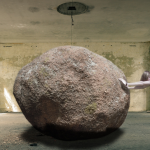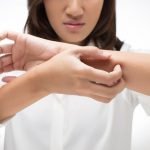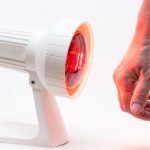Adult Onset Acne: Case Study & Clinical Perspective
Briana Cain, NMD
Tolle Causam
Late-onset adult acne is a condition that seems to be presenting in many naturopathic medical practices at a growing rate. I see roughly 2 new cases of late-onset acne every month, with the majority of these cases being females over the age of 25. Each case comes with its own unique story and history. The possible etiologies for adult-onset acne are numerous, including hormone imbalance, food sensitivities, improper skin-care regimens, environmental toxins, bacterial overgrowth in the skin, stress, genetics, side effects of medications, and an undiagnosed medical condition.1 For these reasons, late-onset adult acne requires the principle of tolle causam to achieve clearance. What follows is the review of a gratifyingly successful case of a patient that I started treating about 18 months ago.
Patient History
ET is a 41-year-old female who presented to my office with acne that was disseminated over her face and included over 15 acneic lesions. The lesions were very red, painful, and cystic (Figure 1). The acne increased with stress and was worse prior to menses. ET was nulliparous and her menstrual cycles were irregular. ET is a business owner and often finds herself under an inordinate amount of stress. She also reported some bloating around the midsection. She was taking a multivitamin and exercising regularly. At the time of her first visit, she was seeing a laser tech/esthetician every 2-4 weeks for acne IPL (Intense Pulsed Light) treatments and facials. The IPL and facials had produced a very minor temporary improvement in her skin. She also had a very extensive skin-care regimen with multiple different products.
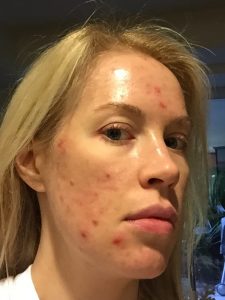
Figure 1. ET Before
Treatment3-6
The etiologies highest on my differential list for this patient included hormone imbalance, inflammation in the digestive tract, and stress management issues. I ran labs, including CMP, CBC, TSH, free T4, free T3, thyroid antibodies, day-21 progesterone, estradiol, testosterone (free and total), DHT, DHEA-S, 25-OH-vitamin D, and an IgG food sensitivity panel. CBC, CMP, the thyroid panel, DHT, vitamin D, estradiol, and testosterone tests all resulted in appropriate levels. Day-21 progesterone and DHEA were low. The food sensitivity panel revealed significant sensitivity to 4 foods.
Her supplementation plan was as follows:
- Continue multivitamin
- Micronized progesterone troche: 100 mg at bedtime, days 18-28 of cycle
- DHEA: 5 mg daily
- Fish oil: 3000 mg daily
- Vitamin A: 50,000-100,000 IU daily (as tolerated without headache), in divided doses
- Proprietary mixed herbal formula to support HPA axis (Rhodiola rosea, Ocimum sanctum [holy basil], Avena sativa, Schisandra chinensis, and Withania somnifera [ashwagandha]): 2 caps daily before 2 PM
- Digestive enzymes with each meal
- Increase water intake to 80 oz daily
- Avoid positive foods on sensitivity test
Follow-up Visits
Three Months
ET had experienced significant improvement in digestive symptoms, mostly decreased bloating. Her cycle had become more regular, occurring at 30-34-day intervals. She reported an increase in energy and improvement in her exercise tolerance and recovery. Stress was still very high. The acne had improved about 35%.
I advised ET to continue the protocol as prescribed and to focus on healthy outlets for stress. We ran labs for progesterone and DHEA, which were much improved. I also advised that ET reduce her skin-care regimen and begin using only a gentle cleanser, fragrance-free moisturizer, and an SPF-sunscreen when outdoors. ET was insistent upon continuing with her retinol cream at bedtime, but I was able to convince her to lower the strength to 0.5% and apply it every other night.
Six Months
ET reported an improvement in her stress level, an increase in exercise frequency. She was feeling really good while taking the progesterone, mostly likely due to improved sleep. The acne did not seem to have improved any further.
I advised ET to discontinue her IPL treatments, as studies indicate only short-term resolution, and I suggested she consider a more aggressive laser treatment to address the overactivation of the sebaceous complexes in the skin.2 She agreed to an ablative laser treatment using a hybrid laser at 1470 nm and 2940 nm. The results were astonishing. ET saw 80% clearance of her acne after the ablative laser treatment. I recommended that ET be treated every 4 weeks with either a non-ablative 1470 nm laser treatment or a glycolic chemical peel.
One Year Later
ET has been very compliant with the supplement and lifestyle recommendations. She continues to avoid her food sensitivities and has started a self-prescribed detox. To date, ET has had 2 non-ablative 1470 nm laser treatments and 4 glycolic chemical peels. She has increased her retinol use to every night but continues to use a gentle cleanser and moisturizer twice daily. ET has maintained an 80% clearance of her acne and reports that any residual lesions are very superficial and no longer painful or cystic (Figure 2).
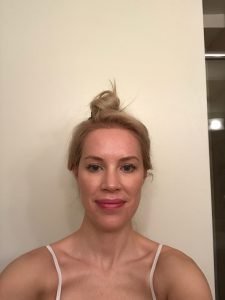
Figure 2. ET After
Her menstrual cycle remains somewhat irregular, with menses occurring every 30-44 days. I recommended a repeat of the initial hormone labs. ET is exercising regularly and invested in some personal development seminars, which have improved the operation of her business and reduced her stress level.
Discussion
In conclusion, I believe ET’s acne was most related to stress levels and GI function. There may or may not have been a hormonal component, as alterations in her deficient hormone levels did not seem to influence the frequency and severity of her acne. The sebaceous complexes in her skin had become overstimulated and hyperactive due to stress and systemic inflammation likely originating in the GI tract. Once those underlying causes were treated, the laser and chemical treatments successfully reduced the hyperactive production of the oil in the skin, and clear skin become a reality for ET. I also speculate that the use of multiple skin-care products, with extensive ingredient lists, were promoting a protective mechanism by the skin of overproduction of sebum and increased inflammation in the dermis.
Adult-onset acne can be difficult to address and requires investigation into a number of causative factors. Managing patient expectations and encouraging patience and compliance with naturopathic therapies is often the key to success when treating this condition.
References:
- Khynger N, Kumar C. A clinico-epidemiological study of adult acne: is it different from adolescent acne? Indian J Dermatol Venereol Leprol. 2012;78(3):335-341.
- Pei S, Inamadar AC, Adya KA, Tsoukas MM. Light-based therapies in acne treatment. Indian Dermatol Online J. 2015;6(3):145-157.
- Hudson T. Women’s Encyclopedia of Natural Medicine. New York, NY: McGraw Hill; 2008: 184-185.
- Gaby AG. Nutritional Medicine. Concord, NH: Fritz Perlberg Publishing; 2011: 667-671.
- Pizzorno JE, Murray MT, Joiner-Bey H. The Clinician’s Handbook of Natural Medicine. New York, NY: Churchill Livingstone; 2002: 3-7.
- Notay M, Foolad N, Vaughn AR, Sivamani RK. Probiotics, Prebiotics, and Synbiotics for the Treatment and Prevention of Adult Dermatological Diseases. Am J Clin Dermatol. 2017;18(6):721-732.
Image Copyright: <a href=’https://www.123rf.com/profile_transurfer’>transurfer / 123RF Stock Photo</a>
 Briana Cain, NMD, is a board-licensed naturopathic medical doctor practicing in Scottsdale, AZ. Dr Cain graduated from the Southwest College of Naturopathic Medicine and Health Sciences in Tempe, AZ. Her primary focus in practice is anti-aging and functional medicine. Dr Cain strives to build an empowering partnership with patients and she develops each treatment plan with the specific needs of an individual patient in mind. She teaches bioidentical hormone replacement therapy to other physicians and is a member of the International Hormone Society. She is also a member of the Arizona Naturopathic Medical Association and the American Association for Anti-Aging and Aesthetic Medicine.
Briana Cain, NMD, is a board-licensed naturopathic medical doctor practicing in Scottsdale, AZ. Dr Cain graduated from the Southwest College of Naturopathic Medicine and Health Sciences in Tempe, AZ. Her primary focus in practice is anti-aging and functional medicine. Dr Cain strives to build an empowering partnership with patients and she develops each treatment plan with the specific needs of an individual patient in mind. She teaches bioidentical hormone replacement therapy to other physicians and is a member of the International Hormone Society. She is also a member of the Arizona Naturopathic Medical Association and the American Association for Anti-Aging and Aesthetic Medicine.







